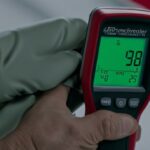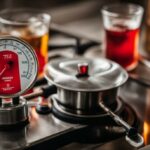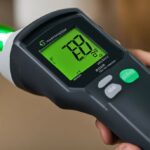Last Updated on 6 months by Francis
Accurate temperature measurements are essential in various fields, from determining the temperature of food or drinks to monitoring the body temperature of a sick individual. Infrared thermometers are a popular tool for measuring temperature because of their convenience and non-contact feature. However, it’s crucial to ensure that the temperature readings are accurate, which is why this guide will show you how to check the accuracy of an infrared thermometer.
In this section, we will cover various methods such as accuracy tests, calibration, and standards to ensure precise temperature readings with your device. You will learn how to maintain your infrared thermometer’s accuracy, the factors influencing its accuracy, and the manufacturer’s specifications to ensure your device meets the required standards.
Contents
Key Takeaways:
- Accurate temperature readings are essential, particularly in fields like healthcare, food safety, and HVAC.
- Infrared thermometers offer the convenience of non-contact temperature measurement, but they must be accurate to obtain reliable results.
- This guide will cover various methods such as accuracy tests, calibration, and comparison with reference thermometer to ensure precise temperature readings.
Understanding Infrared Thermometers

Before we can dive into checking the accuracy of an infrared thermometer, it is crucial to understand how these devices work and the standards and guidelines associated with their accuracy.
Infrared thermometers measure temperature by detecting the amount of thermal radiation emitted by an object or surface. They do not touch the object they are measuring, making them particularly useful in situations where a physical connection is not feasible or safe.
Infrared thermometer accuracy standards and guidelines are established to ensure reliable temperature measurements, and they may vary depending on the application. For example, medical infrared thermometers may have stricter accuracy requirements than those used in food safety or HVAC.
Factors that may affect the accuracy of an infrared thermometer include the emissivity of the object being measured, the distance between the device and the object, and ambient temperature. Manufacturers provide specifications for their infrared thermometers, including the acceptable level of accuracy. Regular calibration is crucial to maintain accuracy and should follow the guidelines set forth by the manufacturer.
Overall, understanding the operational principles of an infrared thermometer and the relevant standards and guidelines is essential to ensure accurate temperature measurements and successful usage in a variety of fields.
Why Checking Accuracy is Important

When it comes to temperature measurements, accuracy is critical. Inaccurate temperature readings can have severe consequences, especially in fields such as medical, food safety, and HVAC. Using an infrared thermometer with an incorrect temperature display can result in misdiagnosis, spoilage of food due to undercooking, or overexposure to dangerous substances in HVAC systems.
That is why verifying the correctness of an infrared thermometer through an infrared thermometer accuracy test is crucial. It not only ensures the safety of individuals but also maintains the efficiency of processes. It is essential to be aware of the accuracy of your infrared thermometer, especially when taking measurements in critical situations.
Regularly checking the accuracy of an infrared thermometer can prevent undesirable outcomes, making it a priority for individuals and organizations that rely on temperature measurements to verify accuracy.
Verifying the accuracy of an infrared thermometer should be a routine part of its overall maintenance. It is a simple process that requires a minimal investment of time and effort, yet it can save a considerable amount of time and resources in the long run. It ensures that the infrared thermometer is providing accurate temperature readings and helps maintain its quality and reliability.
Accuracy Test Methods
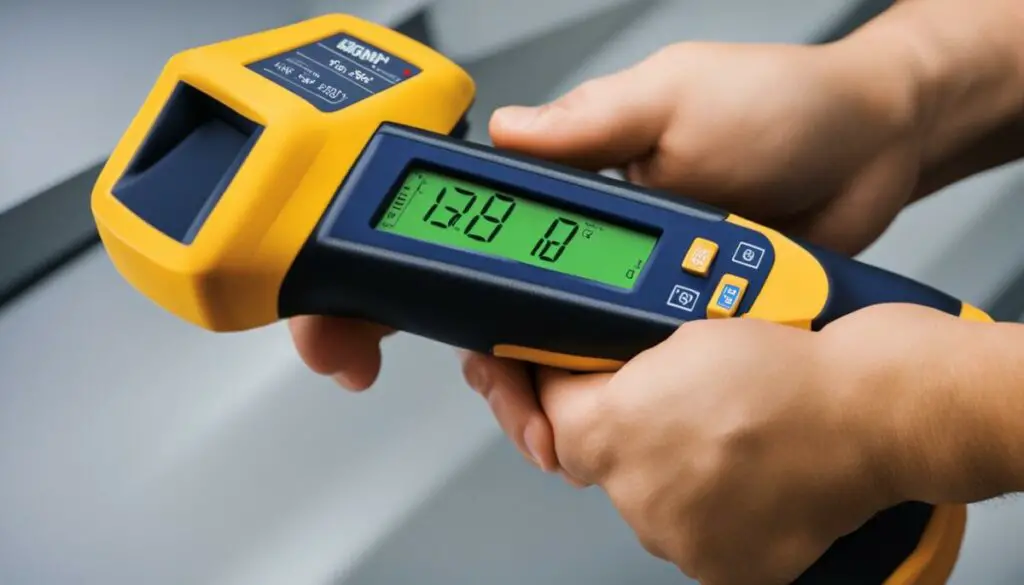
Testing the accuracy of an infrared thermometer is crucial to determine if it is providing reliable temperature readings. There are various methods to conduct an accuracy test, and here are some tips for gauging the accuracy of your infrared thermometer:
- Ice Bath Method: Fill a container with crushed ice and add water to make a slurry. Stir the mixture to ensure a consistent temperature. Place your infrared thermometer in the center of the mixture, ensuring it is not touching the container. The temperature should read 32°F (0°C). Note the measurement, and repeat the process to obtain an average reading.
- Boiling Water Method: Fill a container with boiling water. Make sure to use distilled water to avoid any impurities that can affect the temperature. Place your infrared thermometer in the water, avoiding contact with the container. The temperature should read 212°F (100°C) at sea level. Record the measurement, and repeat the process to obtain an average reading.
- Blackbody Calibration: Blackbody calibration is a precise method to test the accuracy of an infrared thermometer. It involves using a reference device, a black painted object that can emit a constant temperature, to compare the measurements. This method is ideal for professional use, and a specific set of instruments is required.
It is essential to repeat the accuracy test periodically to ensure the device’s consistency. In addition, keep the infrared thermometer’s lens clean and free from dirt or oil, which can affect the reading accuracy.
Calibration of Infrared Thermometers

Calibration is a critical process to ensure the accuracy of your infrared thermometer. The process involves adjusting your device to match the temperature readings of a reference thermometer.
It is recommended to perform infrared thermometer calibration at least once per year or more frequently if you use the device regularly in critical applications.
The calibration process involves the following steps:
- Prepare the device: Turn on your infrared thermometer and let it stabilize for at least 15 minutes to ensure the internal temperature stabilizes.
- Prepare the reference thermometer: Place the reference thermometer in a stable environment with a known temperature and let it stabilize for at least 15 minutes.
- Perform the calibration: Point your infrared thermometer at the reference thermometer and record the temperature reading. If the temperature readings do not match, adjust the device’s calibration until it matches the reference thermometer’s temperature reading.
- Verify the accuracy: After calibration, verify the accuracy of your infrared thermometer by testing it against additional reference thermometers.
You can use professional calibration services or perform the calibration process yourself. However, using a professional calibration service is recommended, especially for critical applications such as medical or food safety.
Table: Comparison of Professional Calibration and Self-Calibration Services
| Professional Calibration | Self-Calibration |
|---|---|
| Performed by experienced professionals in a controlled environment | Performed by inexperienced personnel, increasing the risk of errors |
| Provides documentation and certification of accuracy | No official certification or documentation |
| Recommended for critical applications such as medical or food safety | Suitable for non-critical applications |
Reference Thermometer Comparison
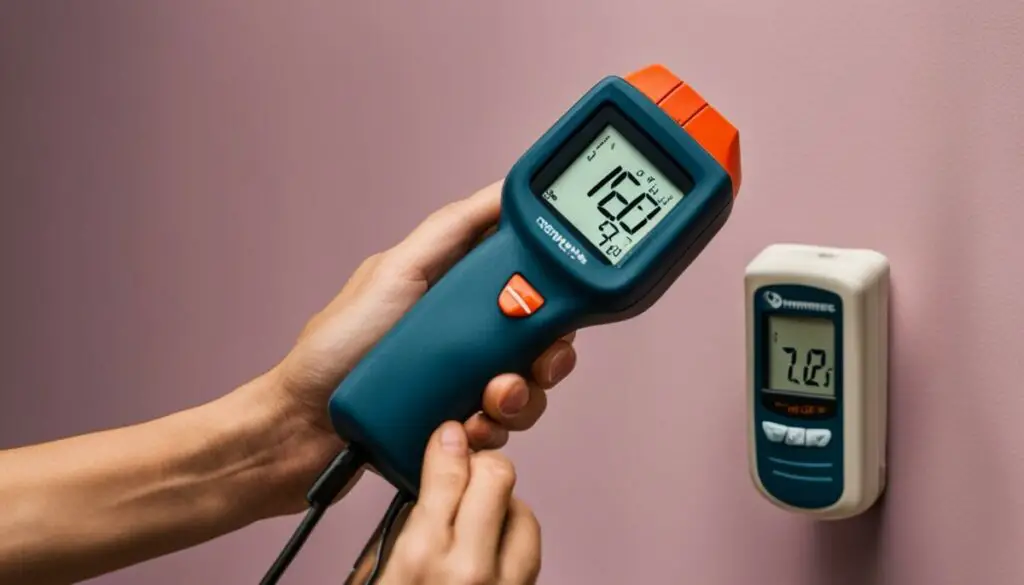
Infrared thermometers can encounter inaccurate temperature measurements due to various factors. It is essential to compare your infrared thermometer readings with a reference thermometer frequently. This ensures the precision of your infrared thermometer and correct temperature readings.
Before comparing your infrared thermometer with a reference thermometer, ensure that both devices have reached a stable temperature. Record the readings of both thermometers simultaneously and at the same distance and angle.
The table below shows an example of a comparison between an infrared thermometer and a reference thermometer:
| Temperature (°F) | Infrared Thermometer Reading | Reference Thermometer Reading | Difference |
|---|---|---|---|
| 80 | 79.8 | 80.5 | +0.7 |
| 90 | 89.7 | 90.2 | +0.5 |
| 100 | 99.8 | 100.5 | +0.7 |
As shown, the difference between the infrared thermometer and the reference thermometer is negligible and acceptable. However, if the difference is more significant, it may indicate that your infrared thermometer requires calibration or has an accuracy issue.
Remember to conduct the reference thermometer comparison regularly, particularly before conducting critical temperature measurements, and ensure that your infrared thermometer remains accurate and reliable.
Environmental Factors Affecting Accuracy
When using an infrared thermometer, it is crucial to consider various environmental factors that can affect its accuracy. These factors include distance, emissivity, and ambient temperature.
The distance between the thermometer and the object being measured can significantly impact the accuracy of the reading. The further the distance, the greater the chance of measuring the temperature of surrounding objects, resulting in an inaccurate reading. As a rule of thumb, it is recommended to maintain a distance-to-spot ratio of at least 12:1. This means that if you are measuring an object 12 inches away, the spot size of the infrared thermometer should be no larger than one inch in diameter.
Emissivity is another critical factor to consider. Emissivity refers to an object’s ability to emit radiation. Different surfaces have varying emissivity levels, meaning that an infrared thermometer may not provide accurate readings for all objects. For example, a shiny or reflective surface may reflect radiation and skew the temperature reading. To compensate for this, many infrared thermometers have adjustable emissivity settings. It is essential to ensure that the emissivity setting matches the surface being measured to obtain accurate readings.
Ambient temperature, the temperature of the surrounding area, can also impact infrared thermometer accuracy. Extreme fluctuations in ambient temperature can affect the performance of the device and cause errors in readings. Additionally, it is recommended to allow the infrared thermometer to acclimate to the ambient temperature of the measurement area before taking readings.
Table: Environmental Factors Affecting Infrared Thermometer Accuracy
| Factors | Impact |
|---|---|
| Distance | Further distance can result in inaccurate readings |
| Emissivity | Incorrect settings can lead to inaccurate readings for reflective surfaces |
| Ambient Temperature | Extreme fluctuations can cause errors in readings |
It is essential to follow the infrared thermometer accuracy guidelines to ensure accurate readings. By taking into account environmental factors and using proper measurement techniques, you can increase the accuracy and reliability of your infrared thermometer.
Checking Manufacturer’s Specifications

Manufacturers provide their infrared thermometers with a set of specifications for accuracy. It is necessary to confirm whether your device meets these specifications. Here’s how to check the accuracy of an infrared thermometer using the manufacturer’s guidelines.
- Check your infrared thermometer’s manual: The manual contains all the necessary information, including the acceptable level of accuracy.
- Look for the calibration procedure: Check if your infrared thermometer has a calibration option. If yes, follow the steps to calibrate it.
- Identify the accuracy level: Look for the accuracy level specification indicating the margin of error. This is usually expressed as +/- something, such as +/- 2 degrees Celsius or Fahrenheit.
- Conduct an accuracy test: Conduct an accuracy test by following the manufacturer’s guidelines. If the results show your device is outside the specified accuracy levels, consider calibrating it or consulting with the manufacturer for repairs.
By checking the manufacturer’s specifications, you can ensure that you are using your infrared thermometer within the acceptable accuracy levels. It is important to note that these levels may differ depending on the manufacturer and the model of the device.
Maintenance and Care for Accuracy
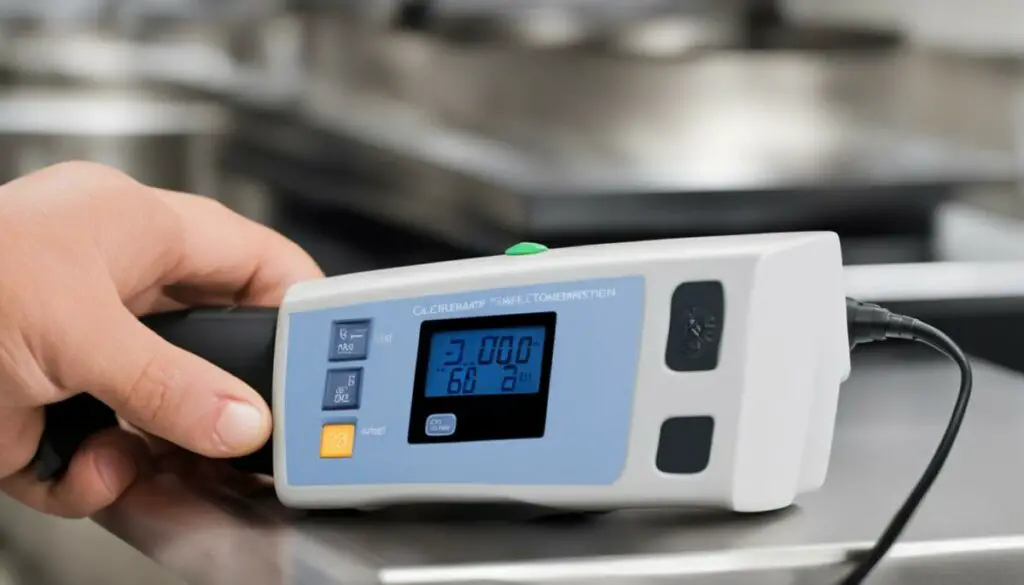
Proper care and maintenance are crucial for ensuring the accuracy of your infrared thermometer. By implementing the following practices, you can increase the longevity of your device and maintain its precision over time.
Regular Calibration
Regular calibration is essential for maintaining the accuracy of your infrared thermometer. It is recommended to calibrate your device at least once a year, or more frequently if you use it frequently or in harsh environments. Follow the manufacturer’s instructions for proper calibration, or consult a professional calibration service.
Cleaning
Keeping your infrared thermometer clean is crucial for accurate temperature readings. Clean the lens and body of the device regularly using a soft, dry cloth. If needed, use a damp cloth with a mild detergent to remove stubborn dirt or residue. Avoid using harsh chemicals or abrasive materials, as they can damage the device.
Storage
Proper storage is important for maintaining the accuracy of your infrared thermometer. Store the device in a dry and clean area, away from direct sunlight, heat sources, or moisture. Avoid exposing the device to extreme temperatures, which can affect its accuracy. Use a protective case or cover to shield the device from dust and physical damage during storage.
Battery
Ensure the battery is always charged or replaced when needed. A low battery can affect the accuracy of your infrared thermometer. Follow the manufacturer’s instructions for battery replacement or charging.
“Taking good care of your infrared thermometer ensures accurate temperature readings and extends the lifespan of the device.”
By following these maintenance and care practices, you can ensure the accuracy and reliability of your infrared thermometer. Remember to calibrate your device regularly, keep it clean and store it properly. Always refer to the manufacturer’s instructions and consult a professional if needed.
Periodic Accuracy Check
It is crucial to verify the correctness of an infrared thermometer periodically to ensure its reliability and accurate temperature readings. The frequency of accuracy checks depends on the device’s usage frequency and the level of accuracy demanded by the application. For example, medical and food safety industries should test their infrared thermometers’ accuracy daily or weekly to ensure precise and consistent readings.
However, for the HVAC industry, monthly calibration and accuracy checks are generally sufficient. Similarly, for personal use, conducting an accuracy check every six months should suffice.
The accuracy test methods discussed earlier in this guide can be used for periodic accuracy checks. It is also essential to follow proper care and maintenance procedures to maintain your device’s accuracy and ensure its longevity.
Remember, a reliable and accurate infrared thermometer is necessary for various applications. Therefore, take the time to periodically check the accuracy of your device and perform necessary maintenance and calibration for optimal performance.
Conclusion
As we conclude this comprehensive guide on how to check the accuracy of an infrared thermometer, we hope that you have gained valuable insights on ensuring reliable temperature measurements. Remember that accuracy tests, calibration, and reference thermometer comparisons are essential methods for gauging the accuracy of your device. Additionally, maintaining your infrared thermometer correctly and periodically checking for accuracy are key to maximizing its performance.
Takeaways
- Accuracy is crucial: Accurate temperature measurements are critical in various fields, from healthcare to food safety and HVAC.
- Regular maintenance: Proper maintenance and care can significantly contribute to the accuracy of your infrared thermometer.
- Follow manufacturer’s specifications: Check and interpret the manufacturer’s specifications to ensure your device meets the required accuracy standards.
- Periodic checks: It is necessary to periodically check the accuracy of your infrared thermometer to ensure consistent and reliable readings.
By following the guidelines and methods highlighted in this guide, you can ensure the correctness of your infrared thermometer and get precise temperature readings. Remember, accuracy is crucial in applications where temperature is a critical parameter, and you want to ensure that your infrared thermometer provides reliable results every time.
FAQ
How can I check the accuracy of my infrared thermometer?
There are several methods to check the accuracy of an infrared thermometer. You can perform an accuracy test using a known temperature source, compare the readings with a reference thermometer, or check the manufacturer’s specifications for acceptable accuracy ranges.
Why is it important to check the accuracy of an infrared thermometer?
Checking the accuracy of an infrared thermometer is crucial to ensure reliable temperature measurements. Inaccurate readings can lead to incorrect diagnoses, compromised food safety, or ineffective HVAC systems. It is important to verify the correctness of your infrared thermometer for accurate results.
How often should I calibrate my infrared thermometer?
It is recommended to calibrate your infrared thermometer regularly, depending on its frequency of use and the manufacturer’s guidelines. Generally, calibration should be performed every 6 to 12 months or as specified by the manufacturer.
Can I compare my infrared thermometer readings with a reference thermometer?
Yes, comparing your infrared thermometer readings with a reference thermometer is a reliable method to check its accuracy. Ensure both thermometers are in a stable environment and measure the same temperature source to gauge the precision of your infrared thermometer.
What environmental factors can affect the accuracy of an infrared thermometer?
Various environmental factors can influence the accuracy of an infrared thermometer. Distance, emissivity of the object being measured, and ambient temperature can impact the readings. It is important to consider these factors and compensate accordingly for accurate results.
How do I interpret the manufacturer’s specifications for my infrared thermometer?
The manufacturer’s specifications provide information about the acceptable level of accuracy for your infrared thermometer. Refer to the provided guidelines to understand the required accuracy standards and ensure your device meets the specified criteria.
How can I maintain the accuracy of my infrared thermometer?
Proper maintenance and care are essential for maintaining the accuracy of your infrared thermometer. Store it in a clean and dry environment, avoid extreme temperatures, and clean the lens regularly with a soft cloth. Additionally, follow the manufacturer’s instructions for any specific maintenance tasks.
How often should I perform accuracy checks on my infrared thermometer?
It is recommended to perform periodic accuracy checks on your infrared thermometer, especially if it is used frequently or in critical applications. The frequency of checks may vary depending on the specific requirements of your industry or the manufacturer’s recommendations.


